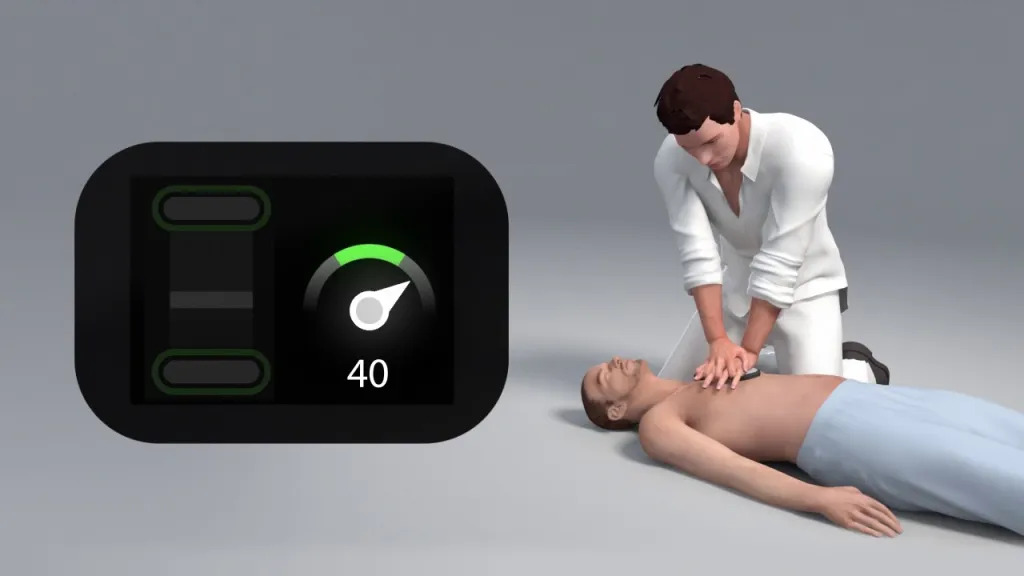What Does a Chest Compression Feedback Device Monitor?
OChest compressions are a vital part of cardiopulmonary resuscitation (CPR). This lifesaving technique can restore blood flow and oxygen to the brain. But what does a chest compression feedback device monitor?
Performing chest compressions correctly and effectively takes work. It requires proper training, practice, and feedback. That’s where a chest compression feedback device comes in handy.
The following post will explain what a chest compression feedback device is, how it works, its advantages and disadvantages, and some alternatives to it.
Also Read: How Long Does Morphine Stay in Your System
What is a Chest Compression Feedback Device?
A chest compression feedback device is a small and portable tool. It can be attached to the patient’s chest and provides real-time feedback on the rate and depth of your compressions. Some devices also use artificial intelligence to monitor the healthcare provider’s hands and provide feedback.
The feedback can be visual, audible, or both. For example, some devices have a screen that displays the compression depth and rate in numbers or graphs. Some widgets have lights that indicate whether the compressions are too shallow or too deep. Their devices have sounds that guide the rhythm of the contractions or alert you if you are going too fast or too slow. Some devices have voice prompts instructing you on improving your technique.
The feedback can also be real-time or delayed. Real-time feedback means getting immediate information on your performance as you perform CPR. Delayed feedback means you get a performance summary or report after you finish CPR.
Components of Chest Compression
What does a chest compression feedback device monitor depends on the understanding of chest compression. According to the AHA guidelines, high-quality chest compressions should have the following characteristics:
Depth
The chest should be compressed at least 2 inches (5 cm) for adults, at least one-third of the anterior-posterior diameter for children, and at least one-fourth of the anterior-posterior diameter of the chest for infants.
Rate
The chest should be compressed at 100 to 120 compressions per minute.
Recoil
The chest should be allowed to fully recoil between each compression without leaning on the chest. Recoil is the complete release of pressure between each contraction, which helps the heart to refill with blood.
Hand Position
The hands should be placed on the lower half of the breastbone (sternum) for adults and children and just below the nipple line for infants.
Also Read: How Long Does Percocet Stay in Your System?
Types of Chest Compression Feedback Devices
There are different types of chest compression feedback devices to understand what does a chest compression feedback device monitor?
Some examples are:
CPRmeter
This device measures the depth and rate of chest compressions using an accelerometer and a force sensor. It provides visual and audible feedback on a screen through sounds and voice prompts. It also has a metronome function that guides the rhythm of compressions.
TrueCPR
This device measures the depth of chest compressions using magnetic field technology. It provides visual and audible feedback on a screen through sounds and voice prompts. It also has a metronome function that guides the rhythm of compressions.
ZOLL PocketCPR
This device measures the depth and rate of chest compressions using an accelerometer. It provides visual feedback through lights and audible feedback through sounds and voice prompts. It also has a metronome function that guides the rhythm of compressions.
Heartisense
This device uses artificial intelligence to monitor the hand position and recoil of the person performing CPR. It provides visual and audible feedback on a screen through sounds and voice prompts. It also has a metronome function that guides the rhythm of compressions.
How Compression Feedback Device Monitors Work?

The chest compression feedback devices work by measuring and providing feedback on the following parameters:
Compression Depth
Compression depth is the distance that the chest is compressed during each compression. It is measured in millimeters (mm) or inches (in). The optimal compression depth depends on the age and size of the patient with no drug effects like meth.
The compression depth is measured by different methods depending on the device. Some devices use an accelerometer, a sensor that detects acceleration or movement. The accelerometer measures how much the machine moves up and down as it is attached to the chest.
Some devices use magnetic field technology, which is a technology that creates and detects magnetic fields. It measures how much the distance between two magnets changes as one magnet is attached to the chest and another to the device.
The compression depth feedback can be visual, audible, or both.
Compression Rate
Compression rate is the number of compressions performed per minute. It is measured in beats per minute (bpm). The optimal compression rate depends on the age and condition of the patient, but generally, it should be between 100 and 120 compressions per minute.
The compression rate is measured by counting the number of compressions performed in a given time interval. The time interval can be set by the device or by the user.
For example, some devices count the number of compressions performed in 15 seconds and multiply it by four to get the compression rate per minute. Some devices allow the user to set the time interval manually.
Compression Recoil
Compression recoil is the complete release of pressure between each compression, which allows the heart to refill with blood. It is measured by detecting whether there is any residual force or movement on the device after each contraction.
The compression recoil feedback can be visual, audible, or both.
Hand Position
Hand position is the placement of hands on the chest during CPR. It affects how effectively and safely chest compressions are performed. The optimal hand position depends on the age and size of the patient, but generally, it should be on the lower half of the breastbone (sternum) for adults and children and just below the nipple line for infants.
The hand position feedback can be visual, audible, or both.
Training and Certification
Training and certification are essential to know what does a chest compression feedback device monitor? Different training and certification programs are available depending on your experience level and your role in CPR.
Some examples are:
Essential Life Support (ELS)
This course teaches adults, children, and infants basic CPR skills, including how to use chest compression feedback devices. It is designed for healthcare professionals and others who must respond to cardiac emergencies.
Heartsaver CPR AED
This course teaches basic CPR skills for adults and children, including how to use chest compression feedback devices. It also teaches how to use an automated external defibrillator (AED) and how to use chest compression feedback devices.
Advanced Cardiovascular Life Support (ACLS)
This course teaches advanced CPR skills for adults, including how to use chest compression feedback devices. It also teaches how to manage cardiac arrest and other life-threatening cardiovascular emergencies using a systematic approach.
Overall Quality of Compressions
The overall quality of compressions is the combination of all the components of chest compression: depth, rate, recoil, and hand position. It reflects how well you perform CPR and how likely you are to achieve a positive outcome for the patient.
The overall quality of compressions can be measured by different methods depending on the device. Some devices use a score or a percentage that indicates how many contractions meet the target criteria for each component. Some machines use a color code or a symbol indicating whether the compressions are reasonable, fair, or poor.
The overall quality of compressions can be improved by using chest compression feedback devices. Several studies have shown that chest compression feedback devices can improve chest compression quality regarding depth, rate, recoil, and overall performance.
Advantages
Chest compression feedback devices have several advantages for improving CPR outcomes and saving lives.
Some of them are:
- They provide objective and accurate information on chest compression quality, which can be tough to assess by human observation or estimation.
- They provide immediate and continuous feedback on chest compression quality, which can help providers correct their errors and maintain their skills.
- They provide consistent and standardized feedback on chest compression quality, which can reduce the variability and uncertainty among different providers.
- They increase the confidence and satisfaction of providers in performing CPR, which can enhance their motivation and performance.
- They increase cardiac arrest patients’ survival rate and neurological outcome, especially when combined with other interventions such as early defibrillation and post-resuscitation care.
Disadvantages
Chest compression feedback devices also have disadvantages or limitations that must be considered.
Some of them are:
- They may be costly or unavailable in some settings or situations, limiting their accessibility and use.
- They may be incompatible or interfere with other devices or equipment used during CPR, such as defibrillators or ventilators.
- Some factors or conditions that influence chest compression quality may be affected or inaccurate, such as the patient’s body size, clothing, chest wall stiffness, or position.
- They may need to be clarified for providers who need to become more familiar with or comfortable using them, which can affect their performance or decision-making.
- They may create overreliance or complacency for providers who depend too much on them and neglect other aspects of CPR quality.
Cost of CPR Feedback Device
The cost of a CPR feedback device varies depending on the type, model, brand, features, and availability. Generally, the price ranges from a few hundred to a few thousand dollars.
For example, the CPRmeter costs about $500; the TrueCPR costs about $1000, the ZOLL PocketCPR expenses about $150, and the Heartisense costs about $200.
Some insurance plans or organizations may cover the cost of CPR feedback devices, depending on the policy and the purpose of use.
For example, some health insurance plans may cover the cost of a CPR feedback device for patients at high risk of cardiac arrest or with a history of cardiac arrest. Some workplaces may provide CPR feedback devices for employees who need CPR in an emergency.
Alternatives Of the Chest Compression Feedback Device Monitor
If a chest compression feedback device monitor is not available or accessible, some alternatives can be used to monitor and improve chest compression quality during CPR.
Some of them are:
Visual Feedback
Visual feedback involves observing the chest’s rise and falls with each compression. It can help to estimate the compression depth and recoil. However, visual feedback may be unreliable, especially in low-light conditions.
Audio Feedback
Audio feedback involves using a metronome or other auditory device to provide a consistent beat for chest compressions. It can help to maintain the compression rate and rhythm. However, more than audio feedback may be required, especially if the compression depth or recoil is inadequate.
Manual Monitoring
Manual monitoring involves checking the pulse and other signs of circulation during CPR. It can help assess chest compressions’ effectiveness and adjust them accordingly. However, manual monitoring may not be feasible or advisable, especially if it causes long or frequent interruptions in chest compressions or if it is difficult to palpate the pulse or other signs.
Simulation Training
Simulation training involves practicing CPR skills on a manikin or a simulator that mimics an actual patient. It can help to learn and improve chest compression quality and receive feedback from an instructor or a device.
However, simulation training may not be available or accessible for everyone, especially if it requires special equipment or facilities.
Also Read: How Long Does Meth Stay in Urine? What You Need to Know
Frequently Asked Questions (FAQs)
Is a Chest Compression Feedback Device Necessary for Performing CPR?
A chest compression feedback device is unnecessary for CPR but can be constructive and beneficial. It can provide objective and accurate information on chest compression quality, which can be challenging to assess by human observation or estimation.
A chest compression feedback device can also provide immediate and continuous feedback on chest compression quality, which can help providers correct their errors and maintain their skills.
Who Can Use a Chest Compression Feedback Device?
Anyone trained and certified in CPR can use a chest compression feedback device. Healthcare professionals, such as doctors, nurses, paramedics, or technicians, can use a chest compression feedback device.
A chest compression feedback device can also be used by first responders, such as firefighters, police officers, lifeguards, or security guards.
Are All Chest Compression Feedback Devices The Same?
No, different chest compression feedback devices are available in the market. They vary in size, shape, design, features, functions, methods, and accuracy. Some devices measure and provide feedback on compression depth only, while others measure and provide feedback on compression rate only.
Some devices measure and provide feedback on both compression depth and rate.
What Does a Chest Compression Feedback Device Monitor Heart Code?
Heart Code is a term the AHA uses to refer to their online CPR training and certification courses. The courses include interactive simulations, videos, animations, quizzes, and tests that teach CPR skills and knowledge.
Heart Code courses also include hands-on practice sessions with a manikin or a simulator that uses a chest compression feedback device to monitor chest compression quality.
Conclusion
What does a chest compression feedback device monitor is interesting to know. Chest compression feedback devices are valuable tools for monitoring and improving chest compression quality during CPR. They can provide objective and accurate information on compression depth, rate, recoil, and hand position.
However, chest compression feedback devices also have some disadvantages or limitations that must be considered. They may be costly or unavailable in some settings or situations, limiting their accessibility and use.
Therefore, chest compression feedback devices should be used as an adjunct to CPR training and practice, not as a substitute for them. Providers should still follow the guidelines and recommendations of the AHA and other international organizations for high-quality CPR.






